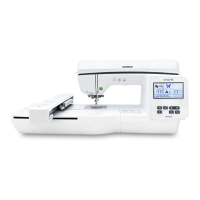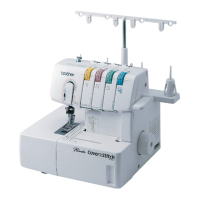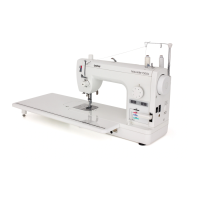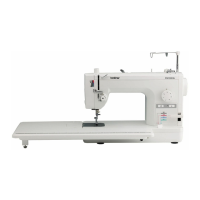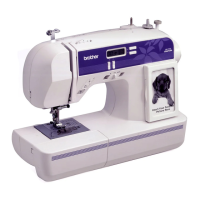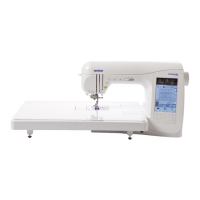Do you have a question about the Brother GS3710 and is the answer not in the manual?
Important safety instructions for operating and maintaining the sewing machine.
Overview of the primary mechanical components of the sewing machine.
Explanation of the machine's drive system and component movements.
Identifies the placement of electronic parts within the machine.
Visual representation of the machine's control system logic.
Procedures for disassembling the main frame and covers.
Procedures for disassembling the main motor unit.
Procedures for disassembling the feed unit.
Procedures for disassembling the needle threading mechanism.
Procedures for disassembling the zigzag mechanism.
Procedures for disassembling the feed control mechanism.
Procedures for disassembling buttonhole and pattern mechanisms.
Procedures for disassembling the upper shaft, needle bar, and presser foot unit.
Procedures for assembling the upper shaft, needle bar, and presser foot unit.
Procedures for assembling the main frame and covers.
Detailed application of disassembly for main frame and covers.
Detailed application of disassembly for the main motor unit.
Detailed application of disassembly for the feed unit.
Detailed application of disassembly for the needle threading mechanism.
Detailed application of disassembly for the zigzag mechanism.
Detailed application of disassembly for the feed control mechanism.
Detailed application of disassembly for buttonhole and pattern mechanisms.
Detailed application of disassembly for the upper shaft, needle bar, and presser foot unit.
Steps to remove machine covers prior to making adjustments.
Procedure for inspecting the needle point for damage.
Adjusting the timing belt tension for proper operation.
Adjusting the motor belt tension for correct speed and power.
Adjusting the position of the stopper L for the needle bar supporter.
Adjusting the position of the stopper R for the needle bar supporter.
Adjusting the timing of the needle's oscillating movement.
Adjusting needle drop positions for consistent sewing.
Adjusting clearance between needle and hook.
Adjusting needle drop for zigzag stitches.
Adjusting needle drop relative to presser foot hole.
Adjusting the position of the inner rotary hook plate.
Adjusting needle bar upward movement from lowest point.
Adjusting the vertical position of the needle bar.
Adjusting clearance between needle and outer rotary hook.
Adjusting left needle drop for straight and zigzag stitches.
Adjusting feed dog position for accurate fabric feeding.
Adjusting the vertical height of the feed dog.
Adjusting the height of the presser bar.
Adjusting the tension of the upper thread.
Adjusting stitch length for SS (triple stretch) patterns.
Adjusting the distance the fabric is fed.
Adjusting stitch length for straight forward and reverse sewing.
Adjusting the load required to operate the BH lever switch.
Adjusting stitch length for left reverse stitches in buttonholes.
Adjusting feed distance for BH stitch bar tacks.
Adjusting the length of the stitch bar tack for BH sewing.
Adjusting the bobbin winding mechanism for proper thread winding.
Adjusting the automatic needle threading mechanism.
Adjusting the tension of the lower thread.
Steps to diagnose and fix issues with the sewing lamp.
Diagnosing and resolving issues with the main motor's operation.
Instructions for wiring the motor 3P supply assembly.
Guidelines for wiring the LED lamp in the sewing machine.
Important safety instructions for operating and maintaining the sewing machine.
Overview of the primary mechanical components of the sewing machine.
Explanation of the machine's drive system and component movements.
Identifies the placement of electronic parts within the machine.
Visual representation of the machine's control system logic.
Procedures for disassembling the main frame and covers.
Procedures for disassembling the main motor unit.
Procedures for disassembling the feed unit.
Procedures for disassembling the needle threading mechanism.
Procedures for disassembling the zigzag mechanism.
Procedures for disassembling the feed control mechanism.
Procedures for disassembling buttonhole and pattern mechanisms.
Procedures for disassembling the upper shaft, needle bar, and presser foot unit.
Procedures for assembling the upper shaft, needle bar, and presser foot unit.
Procedures for assembling the main frame and covers.
Detailed application of disassembly for main frame and covers.
Detailed application of disassembly for the main motor unit.
Detailed application of disassembly for the feed unit.
Detailed application of disassembly for the needle threading mechanism.
Detailed application of disassembly for the zigzag mechanism.
Detailed application of disassembly for the feed control mechanism.
Detailed application of disassembly for buttonhole and pattern mechanisms.
Detailed application of disassembly for the upper shaft, needle bar, and presser foot unit.
Steps to remove machine covers prior to making adjustments.
Procedure for inspecting the needle point for damage.
Adjusting the timing belt tension for proper operation.
Adjusting the motor belt tension for correct speed and power.
Adjusting the position of the stopper L for the needle bar supporter.
Adjusting the position of the stopper R for the needle bar supporter.
Adjusting the timing of the needle's oscillating movement.
Adjusting needle drop positions for consistent sewing.
Adjusting clearance between needle and hook.
Adjusting needle drop for zigzag stitches.
Adjusting needle drop relative to presser foot hole.
Adjusting the position of the inner rotary hook plate.
Adjusting needle bar upward movement from lowest point.
Adjusting the vertical position of the needle bar.
Adjusting clearance between needle and outer rotary hook.
Adjusting left needle drop for straight and zigzag stitches.
Adjusting feed dog position for accurate fabric feeding.
Adjusting the vertical height of the feed dog.
Adjusting the height of the presser bar.
Adjusting the tension of the upper thread.
Adjusting stitch length for SS (triple stretch) patterns.
Adjusting the distance the fabric is fed.
Adjusting stitch length for straight forward and reverse sewing.
Adjusting the load required to operate the BH lever switch.
Adjusting stitch length for left reverse stitches in buttonholes.
Adjusting feed distance for BH stitch bar tacks.
Adjusting the length of the stitch bar tack for BH sewing.
Adjusting the bobbin winding mechanism for proper thread winding.
Adjusting the automatic needle threading mechanism.
Adjusting the tension of the lower thread.
Steps to diagnose and fix issues with the sewing lamp.
Diagnosing and resolving issues with the main motor's operation.
Instructions for wiring the motor 3P supply assembly.
Guidelines for wiring the LED lamp in the sewing machine.
| Type | Mechanical |
|---|---|
| Number of Stitches | 37 |
| Buttonhole Styles | 1 |
| Sewing Speed | 800 stitches per minute |
| Free Arm | Yes |
| Needle Threader | Yes |
| Adjustable Stitch Length | Yes |
| Adjustable Stitch Width | Yes |
| Voltage | 220-240V |
| Power | 70W |
| Bobbin Type | Drop-in bobbin |


